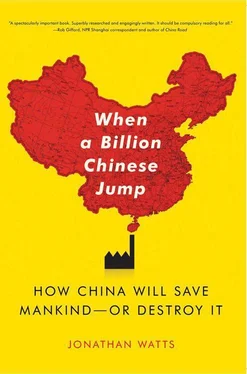Cohen, Joel. “Human Population Grows Up.” Scientific American, September 2005.
Cyranoski, David. “Putting China’s Wetlands on the Map.” Nature, March 11, 2009.
———. “Visions of China,” Nature, July 24, 2008.
Dai Qing (ed.). Beijing’s Water Crisis 1949–2008. Olympics . Probe International, 2008.
Deng Xiangzheng, Huang Jikun, Scott Rozelle, and Emi Uchida. “Cultivated Land Conversion and Potential Agricultural Productivity in China.” China Academy of Sciences, July 2005.
Dikotter, Frank. “The Limits of Benevolence: Wang Shiduo (1802–1889) and Population Control.” Bulletin of the School of Oriental and African Studies 55, 1 (1992).
Economy, Elizabeth. “The Great Leap Backward?” Foreign Affairs 86, 5 (September/October 2007).
Elvin, Mark. “The Environmental Legacy of Imperial China,” in Richard Louis Edmonds (ed.), Managing the Chinese Environment. Oxford University Press, 1998, pp. 9–32.
Figueres, Christiana. “The Ethics of Global Climate Change.” Center for Sustainable Development in the Americas, April 2000.
Forest Trends. “China and the Global Market for Forest Products,” www.forest-trends.org, March 2006.
Kleinn, Christoph, Yang Yongping, Horst Weyerhäuser, and Marco Stark. “The Sustainable Harvest of Non-Timber Forest Products in China: Strategies to Balance Economic Benefits and Biodiversity Conservation.” Sino-German Center for Research Promotion, 2006.
Lee, K. S., M. W. N. Lau, and B. P. L. Chan. Wild Animal Trade Monitoring at Selected Markets in Guangzhou and Shenzhen, Southern China, 2000–2003. Kadoorie Farm and Botanic Garden, Hong Kong, 2004.
Leliaert, Frederik, Zhang Xiaowen, et al. “Identity of the Qingdao Algal Bloom.” Phycological Research 57 (2009): 147–51.
Lewis, Nathan. “Powering the Planet.” California Institute of Technology, 2007.
Li Guoying. “Keep Healthy Life of Rivers: A Case Study of the Yellow River.” Yellow River Conservancy Commission.
Li Junfeng. “China’s Wind Power Development Exceeds Expectations.” Worldwatch Institute, www.worldwatch.org, June 2, 2008.
Li Zijun. “Soil Quality Deteriorating in China, Threatening Public Health and Ecosystems.” Worldwatch Institute, www.worldwatch.org, July 27. and September 7, 2006.
Lin Erda et al. “Investigating the Impacts of Climate Change on Chinese Agriculture.” China-UK Collaborative Project, www.dfid.gov.uk, 2008.
Liu Xiaoyan, Zhou Jianbo, and Yu Songlin. “Practice of Water Regulation on the Yellow River.” Yellow River Conservancy Commission Paper.
Logan, Graham A., J. M. Hayes, Glenn B. Hieshima, and Roger E. Summons. “Terminal Proterozoic Reorganization of Biogeochemical Cycles.” Nature, July 6, 2002.
Ma Jun. “Overexploitation of Southwestern Hydropower Unhelpful to China’s Energy Conservation and Pollution Control.” Reform and Opening-up Study Series: Poverty Reduction and Sustainable Development in Western China. Social Sciences Academic Press (China), December 2008.
Ma Tianjie. “Environmental Mass Incidents in Rural China,” China Environment Series 10 (2008–2009). Woodrow Wilson International Center for Scholars.
Mao Yushi, Sheng Hong, and Yang Fuqiang. “True Cost of Coal.” Greenpeace, the Energy Foundation, and WWF, October 27, 2008.
Martin, Ronald. “Secular Increase in Nutrient Levels through the Phanerozoic: Implications for Productivity, Biomass, and Diversity of the Marine Biosphere.” Palaios 11, 3 (1996): 209–19.
McKinsey & Co. “The Coming of Age: China’s New Class of Wealthy Consumers.” www.mckinsey.com, 2009.
Ministry of Science and Technology, China Meteorology Administration, and the Chinese Academy of Sciences. First National Climate Change Assessment. 2006.
Moseley, Robert. “Historical Landscape Change in Northwestern Yunnan, China: Using Repeat Photography to Assess the Perceptions and Realities of Bio-diversity Loss.” Mountain Research and Development 26, 3 (August 2006): 214–19.
Moseley, Robert K., and Tang Ya. “Vegetation Dynamics in the Dry Valleys of Northwestern Yunnan, China During the Last 150. Years: Implications for Ecological Restoration.” Journal of Planet Ecology 30, 5 (2006): 713–22.
Müller, Benito, Niklas Höhne, and Christian Ellermann. “Differentiating (Historic) Responsibilities for Climate Change.” Oxford Institute for Energy Studies. www.oxfordclimatepolicy.org, 2008.
NASA Earth Observatory. “Dust Storm Over East Asia.” http://earthobservatory.nasa.gov, March 2008.
Ni Honggang and Eddy Zeng. “Law Enforcement and Global Collaboration Are the Keys to Containing E-Waste Tsunami in China.” Environmental Science and Technology Viewpoint 43 (2009): 3991–94.
Nickum, James. “Water Management: It’s the Economics, Stupid.” China Economic Quarterly, June 2009.
Ochirkhuyag, L., and R. Tsolmon. “Monitoring the Source of Transnational Dust Storms in Northeast Asia.” Wildlife Conservation Society Mongolia Program and National University of Mongolia, School of Physics-Electronics. International Archives of the Photogrammetry, Remote Sensing and Spatial Information Sciences (Beijing) 37 (2008).
Oldfield, Philip, and Antony Wood. “2008 a Bumper Year for Skyscrapers, Although the Future Remains Uncertain.” Council on Tall Buildings and Urban Habitat. www.ctbuh.org, January 26, 2009.
Olympic press conference transcripts. Wang Sumei (vice director of the Beijing Landscape Forestation Bureau) and Qiang Jian (vice director general of the Beijing Landscape Forestation Bureau). “Landscape and Forestry of Beijing.” Official website of the Beijing 2008 Olympic Games. July 7, 2008. http://en.beijing2008.cn.
Organisation for Economic Cooperation and Development. “Integrating Biodiversity Concerns into the Forestry Sector.” In OECD Environmental Performance Reviews: China 2007, OECD, 2007.
Pew Center on Global Climate Change, with the Asia Society. “Common Challenge, Collaborative Response: A Roadmap for U.S.-China Cooperation on Energy and Climate Change.” January 2009. www.pewclimate.org.
Pickles, Michael. “Implementing Ecologically Sustainable Development in China: The Example of Heilongjiang Province.” Georgetown International Environmental Law Review, April 1, 2002.
Pomeranz, Kenneth. “The Great Himalayan Watershed: Agrarian Crisis, Mega-Dams and the Environment.” New Left Review 58 (July/August 2009).
Samuelsson, Fredrik. “The Potential for Quality Production in Birch Stands in North-Eastern China Using Different Precommercial Thinning Strategies.” MSc thesis, Southern Swedish Forest Research Center, June 2006.
Sayle, Murray. “Overloading Emoh Ruo: The Rise and Rise of Hydrocarbon Civilisation.” Griffith Review 12: Hot Air: How Nigh’s the End? Griffith University, 2006.
Sayer, Jeffrey A., and Changjin Sun. “Impacts of Policy Reforms on Forestry Environments and Biodiversity,” in William F. Hyde, Brian Belcher, and Jintao Xu (eds.). China’s Forests: Global Lessons from Market Reforms. Resources for the Future, 2003, pp. 177–94.
Shieh, Shawn. “China’s Quiet Activists.” YaleGlobal, February 25, 2009. http://yaleglobal.yale.edu.
Song Weiming, Chen Baodong, Zhang Shengdong, and Meng Xianggang. “Russian Logs in China: The Softwood Commodity Chain and Economic Development in China.” Beijing Forestry University, Forest Trends and Rights and Resources, www.forest-trends.org, 2007.
Steinfeld, Edward. “MIT Report Debunks China Energy Myth.” MIT News, October 7, 2008. web.mit.edu/newsoffice/2008/china-energy-1006.html, 7 October 2008.
Читать дальше










